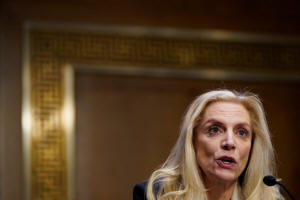Fed united on inflation front as Brainard rejects early rate cuts
 Send a link to a friend
Send a link to a friend
 [October 01, 2022] By
Michael S. Derby [October 01, 2022] By
Michael S. Derby
NEW YORK (Reuters) - The Federal Reserve's
No. 2 official on Friday added her full endorsement of the U.S. central
bank's higher-for-longer game plan for interest rates to curb inflation
that new data shows is still running at more than three times
policymakers' 2% target.
In her first public remarks since the Fed's decision last week to raise
its benchmark interest rate by three-quarters of a percentage point for
a third straight time, Fed Vice Chair Lael Brainard said: "Monetary
policy is focused on restoring price stability in a high-inflation
environment."
"It will take time for the full effect of tighter financial conditions"
caused by rate rises to work its way through the economy and lower price
pressures, Brainard said in a speech to a New York Fed conference
focused on financial stability and monetary policy.
As that process plays out, "monetary policy will need to be restrictive
for some time to have confidence that inflation is moving back to
target. For these reasons, we are committed to avoiding pulling back
prematurely."

Brainard said it was far too soon to declare victory over price
pressures. "Inflation is very high in the United States and abroad, and
the risk of additional inflationary shocks cannot be ruled out."
Fed officials have continued in the past week to beat the drum for an
aggressive campaign to lower the highest levels of inflation seen in the
United States in 40 years. The central bank's policy rate is now in the
3.00%-3.25% range, a full 3 percentage points higher than where it was
at the start of 2022, and policymakers have penciled in more rate rises
later this year and in 2023.
Brainard's remarks indicate she is in stride with her Fed colleagues who
have said they must see clear evidence of slowing inflation before they
let up on the policy tightening.
San Francisco Fed President Mary Daly said in an interview on Newsy, an
online news program, that lowering inflation is the central bank's main
mission, adding that "before we get ahead of ourselves and worry about
recession, I think we should just get the economy slowing in the way
that we need to" bring down inflation.
Speaking separately, Richmond Fed President Thomas Barkin said he was
more worried about inflation becoming sticky than in the prospect that
the central bank had pushed too hard with its rate hikes.
"At this point the risk of inflation festering feels like a bigger risk
than inflation coming down on its own and us having oversteered," Barkin
said in comments to reporters after remarks to business officials in
Virginia.
INFLATION STILL ELEVATED
The Fed officials' remarks coincided with the release of the latest
reading of the Fed's preferred measure of inflation, which showed price
pressures remain a problem.
The personal consumption expenditures price index rose 6.2% in August
from the same month a year ago, a small moderation from the 6.4%
year-over-year increase seen in July. But when stripped of food and
energy costs, the index increased 4.9% from August 2021, versus the 4.7%
year-over-year rise seen in the month before.
A separate inflation measure released by the Dallas Fed on Friday that
excludes items with the largest price swings also rose in August, a sign
that price pressures remained broad throughout the economy.
[to top of second column] |

Federal Reserve Board Governor Lael
Brainard testifies before a Senate Banking Committee hearing on her
nomination to be vice-chair of the Federal Reserve, on Capitol Hill
in Washington, U.S., January 13, 2022. REUTERS/Elizabeth Frantz

The inflation data matched other recent reports that showed a
broadening of underlying inflation in the U.S. economy, which should
keep the Fed on track for aggressive rate rises in the coming
months.
Graphics: Rates up, inflation sideways Rates up, inflation sideways
- https://graphics.reuters.com/USA-FED/FOMC/lbpgnkeyrvq/chart.png
That said, there was some positive news in the outlook for price
pressures. The University of Michigan's consumer sentiment survey
for September found that the public's projected five-year-ahead
inflation outlook cooled.
"Inflation expectations are likely to remain relatively unstable in
the months ahead, as consumer uncertainty over these expectations
remained high and is unlikely to wane in the face of continued
global pressures on inflation," the Michigan survey said.
Fed officials believe where inflation now stands is strongly
influenced by its expected path. Officials have said the relative
stability of long-term inflation expectations shows public
confidence that the central bank will eventually get inflation back
to its 2% target.
In her remarks on Friday, Brainard noted the destination point of
Fed rate hikes is not clear at this time.
"Uncertainty is currently high, and there are a range of estimates
around the appropriate destination of the target range for the
cycle," she said. The Fed will have to feel its way forward and see
how its rate rises work through the economy, and will act
"deliberately and in a data-dependent manner" with future policy
actions.
Brainard also took stock of the potential for "cross-border
spillovers and spillbacks" as the Fed and other major central banks
ratchet up interest rates to combat inflation.
Financial markets across the world have been facing high levels of
volatility, particularly this week, and the dollar's value against
key currencies has surged, fueling concern that the Fed's domestic
mission could cause major problems elsewhere.

Brainard said the Fed is closely watching how its policy actions
affect the global economy and financial system, adding that Fed
officials and policymakers in other nations are in contact.
"We are attentive to financial vulnerabilities that could be
exacerbated by the advent of additional adverse shocks," said
Brainard, a former top U.S. Treasury official in charge of
international issues.
She also laid out areas where parts of the world could run into
trouble, but did not say that any particular problems appeared
imminent or of a magnitude that would change the Fed's current
monetary policy path.
(Additional reporting by Ann Saphir, Lindsay Dunsmuir and Howard
Schneider; Editing by Paul Simao)
[© 2022 Thomson Reuters. All rights
reserved.]
This material may not be published,
broadcast, rewritten or redistributed.
Thompson Reuters is solely responsible for this content. |